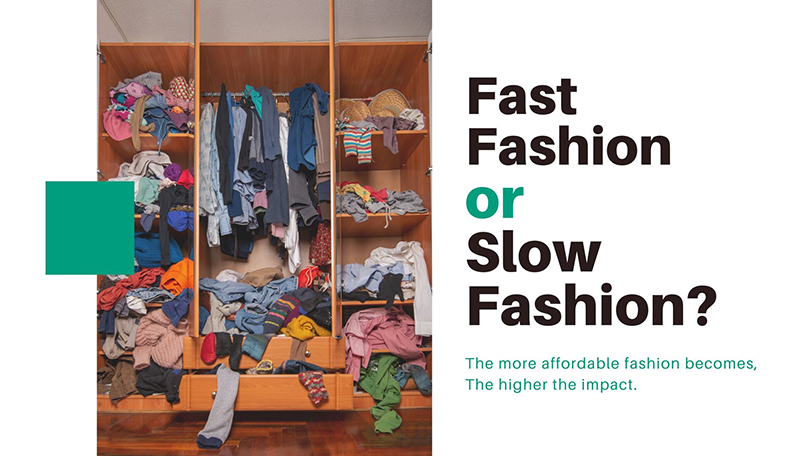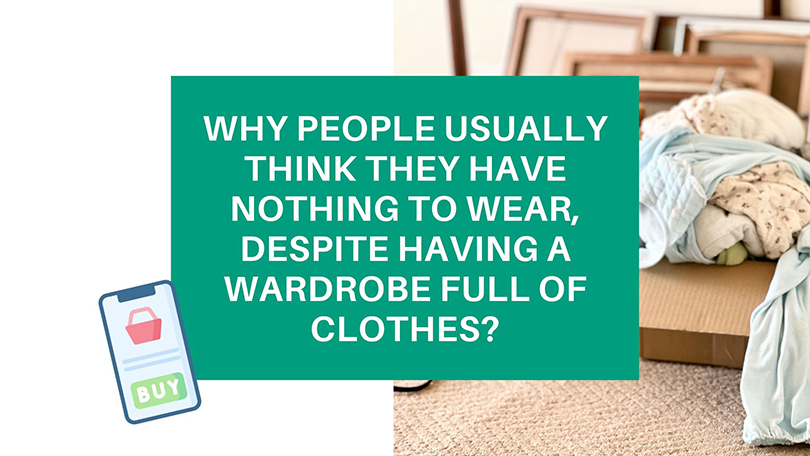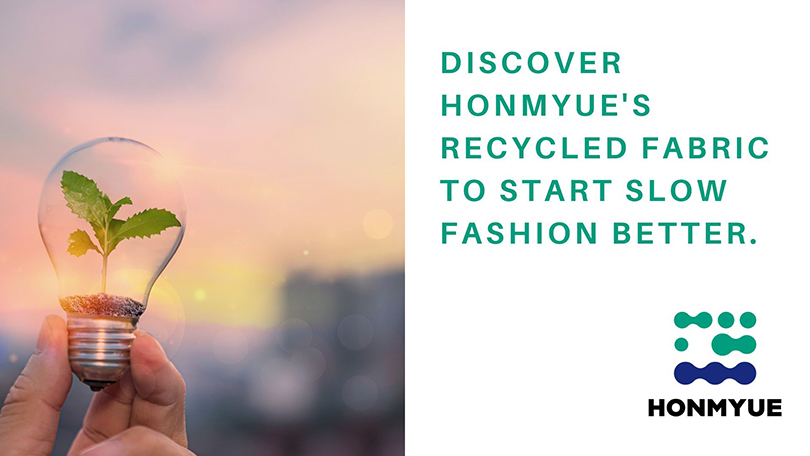2022.10.27Fast Fashion vs Slow Fashion: Eco Recycled Fabric Matters

Why people usually think they have nothing to wear, despite having a wardrobe full of clothes?

Why is there always one missing in your wardrobe? Clothes shopping used to be an occasional event, only happening a few times a year when the seasons changed or what we were wearing was no longer useful. But now, cheap clothing is readily available on the high streets or in online shops, and trend cycles sped up. Even clothes shopping has become a veritable leisure activity stoked by social media. The desire for fresh looks lets you be tempted to constantly revamp your wardrobe. But what is the true cost of these constant wardrobe changes for the environment?
What is "Fast Fashion"?

Everyone like the new trend, or doesn't want to be left out. Fast fashion is typically defined as low prices with fast and mass production of clothes to reflect quickly changing latest trends.
Before, the fashion industry traditionally ran for four seasons a year. But nowadays, the advancement of global supply chains and textile technology has seen prices plummet and choices soar. Fast fashion brands produce about 52 micro-seasons a year or one new "collection" a week. Many leading brands are proudly seasonless to give consumers what they want when they want it.
The Hidden Mystery Behind Fast Fashion.

Fast fashion may sound like an ideal way to purchase clothing, but it's harmful both environmentally and human rights. The main cause of the situation comes from consumer costs. Do you remember how much you paid for your clothes?
The more affordable fashion becomes, the higher the impact.
A lot of fast fashion consumers believe they are saving money, But remember that, as the consumer, you get what you pay for. Clothes have to be made out of lower quality materials to sell for a low cost. Most of them are made from synthetic fiber, both durable and cheap. But poly contains lots of microplastic that lead to the pollution of our oceans, consumed by marine life and even humans. As an estimate, it takes 200 tonnes of water to produce 1 tonne of dyed fabric. Assuming that each person drinks 2.5 liters of water a day, it is enough to sustain three years! In actuality, people usually purchased far more than they wore. Three-fifths of fast fashion clothing ends up in landfill within a year of purchase. The more clothes get thrown away, the more new clothes have to be made, which fuels an endless waste cycle. When factoring in the entire lifecycle of a garment, from manufacturing to transportation to, ultimately, ending up in a landfill, a total of 1.2 billion tonnes of carbon emissions are released every year. In addition to environmental pollution, the human cost is the hidden cost of the fast fashion industry. To keep the low costs, many companies outsource their labor to factories overseas. However, these factories don’t regulate like factories in lower-income countries. From health problems to dangerous working conditions, factory accidents, and grossly low wages, the exploitation of factory workers has persisted.What Everybody Ought To Know About Slow Fashion

Fast fashion clothes are made in large quantities, cheap and trend-sensitive. But good quality is less important to them. However, it is not a very sustainable fashion. In 2007, the specific phrase "Slow Fashion" was first coined in an article by Kate Fletcher.
"Slow fashion is about designing, producing, consuming, and living better. It's not time-based but quality-based (which has some time components). Slow is not the opposite of fast – there is no dualism – but a different approach in which designers, buyers, suppliers, and consumers are more aware of the impacts of products on workers, communities, and ecosystems." - Kate Fletcher
In recent years, the issue of sustainable development has attracted much attention. A brand like H&M set targets that commit to only using sustainable materials in their production by 2030. Although the fashion industry needs to step up and make improvements, Honmyue as a fabric supplier also has a role to play. In addition to using recycled materials (such as post-industrial waste, the abandoned fishing nets, plastic bottles, used clothes, etc.) as the base to make fabrics, we are also committed to designing fabrics that can go from cradle to cradle.
Discover Honmyue's Recycled Fabric To Start Slow Fashion Better

Make sure that today's fashion never has to become tomorrow's problem!
To be Honest, the cost of creating a sustainable fabric is not cheap, but you can rest assured that you are not only investing in a quality fabric but also supporting the future of the planet. Make sure that today's fashion never has to become tomorrow's problem!
- Recycled Nylon / Recycled Polyamide
The recycled nylon comes from industrial processes - scraps of material in factory (yarn factories or our weaving mills) that would have otherwise been landfilled. - Recycled Polyester / Recycled PET
The recycled polyester is made from post-consumer waste. The waste material comes from used plastic bottles, keeping plastics from going to landfill and ocean. - Solution Dyed / Dope Dyed / Waterless Dyed
Solution Dyed have colors added at the very start - pigment is mixed with nylon or polyester pellets prior to spinning into yarn. that eliminates the need for baths of dye - slashing water consumption, one of the fabric industry's most wasteful resources. - Recycled Ocean Waste
The abandoned nylon fishing nets are the biggest source of plastic waste in our oceans. Sea Creatures that become entangled in abandoned fishing nets will choke or even starve to death. Honmyue cooperates with King Chou company which specializes in the production of fishing gear. We regenerate the abandoned nets with the cleaned and shredded process, turn them back into raw material, and become yarns. - Bio-Degradable
Generally, biodegradable clothes are made from natural materials. But plastic materials are chemically produced so it's hard to be biodegradable. Finally, they will release these chemicals back into the environment. Adding anaerobic bacteria in the manufacturing process makes the fabric bio-degraded. With time, they would eventually break down into nontoxic substances.
Reference
https://www.thegoodtrade.com/features/what-is-fast-fashion
https://www.keepbritaintidy.org/news/waste-less-live-more-slow-down-fast-fashion
https://goodonyou.eco/what-is-fast-fashion/
https://www.myimperfectlife.com/features/is-social-media-changing-our-opinions-towards-fast-fashion
https://www.ivint.org/fast-fashion-everything-you-need-but-at-what-cost/
https://www.checinternational.org/the-ultimate-guide-to-fast-fashion-in-2022/
https://www.panaprium.com/blogs/i/fast-fashion-cheap
https://highschool.latimes.com/american-school-of-dubai/the-fast-fashion-fallacy-hidden-costs-of-the-clothing-industry/
https://www.elliss.co.uk/sustainable-fashion/fast-fashion/
https://www.gvm.com.tw/article/41730
https://medium.com/age-of-awareness/lets-talk-about-fast-fashion-da049637e3cd
https://www.thegoodtrade.com/features/what-is-slow-fashion
https://rareandfair.com/blogs/the-slow-scoop/fast-fashion-vs-slow-fashion
https://www.onlineclothingstudy.com/2020/03/cradle-to-cradle-approach-in-fashion.html
https://oceans-and-fisheries.ec.europa.eu/news/circular-economy-abandoned-fishing-nets-sustainable-clothing-2020-10-27_en